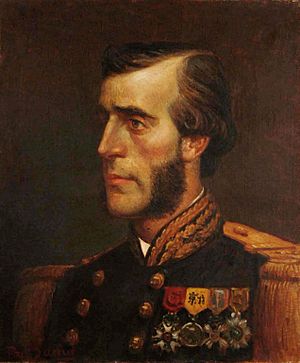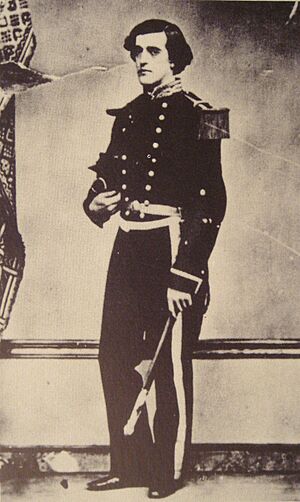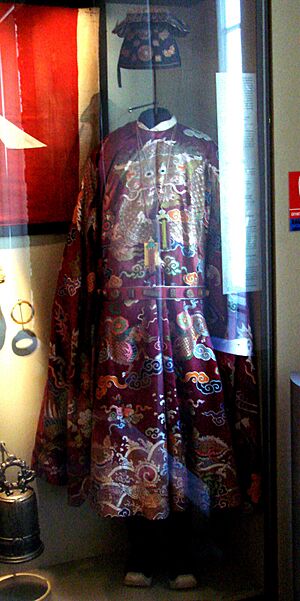Francis Garnier facts for kids
Quick facts for kids
Francis Garnier
|
|
|---|---|

Lieutenant de vaisseau Francis Garnier
|
|
| Birth name | Marie Joseph François Garnier |
| Born | 25 August 1839 Saint-Etienne, France |
| Died | 21 December 1873 (aged 34) Hanoi, Vietnam |
| Allegiance | |
| French navy | |
| Years of service | 1855-1873 |
| Rank | Lieutenant |
| Battles/wars | Second Opium War Cochinchina Campaign Franco-Prussian War |
| Awards | Legion of Honour |
| Spouse(s) |
Claire Knight
(m. 1870) |
| Children | 1 |
Marie Joseph François Garnier (Vietnamese: Ngạc Nhi; 25 July 1839 – 21 December 1873) was a French officer and explorer. He was known for leading a major expedition to explore the Mekong River in Southeast Asia during the 1860s. He also played a key role in French military actions in Vietnam.
Contents
Early Life and Military Service
Francis Garnier was born on 25 July 1839 in Saint-Étienne, France. When he was 16, in 1855, he joined the Ecole Navale, a naval academy. His family was worried about him choosing a dangerous military career.
In 1860, at age 20, Garnier was a junior officer candidate on a ship called the Duperré. During the Second Opium War, he bravely jumped into a stormy sea at night to save a fellow officer who had fallen overboard. Because of this brave act, he was quickly promoted to a junior officer rank called ensign. He then joined the staff of Admiral Charner.
Under Admiral Charner, Garnier fought in the Cochinchina Campaign, which involved military actions in a region of Vietnam. He notably took part in a fierce battle called the storming of the Kỳ Hòa lines.
After spending some time back in France, Garnier returned to Southeast Asia in 1862. He was given a job as an inspector of local affairs in French Cochinchina, a French territory in Vietnam. He was put in charge of managing Cholon, a busy area near Saigon.
Exploring the Mekong and Yangtze Rivers
It was Garnier's idea to send a mission to explore the Mekong River valley. However, he was considered too young to lead it, so Captain Ernest Doudart de Lagrée was put in charge. During this expedition, which lasted from 1866 to 1868, Garnier played a huge role.
A famous geographer, Sir Roderick Murchison, later said that the expedition traveled 5,392 miles from Kratié in Cambodia to Shanghai in China. Of this distance, 3,625 miles were in areas unknown to Europeans. Garnier himself did almost all the important measurements and observations to map these new areas. For his amazing work, he received a special award called the Patron's Medal from the Royal Geographical Society in London in 1870.
Garnier also volunteered to lead a small group to Dali, the capital of a Muslim rebel leader named Sultan Suleiman in Yunnan, China. He successfully completed this very risky journey. When Captain Lagrée died shortly after, Garnier took over command of the expedition. He safely led the group to the Yangtze River and then to the Chinese coast. When he returned to France, people were very excited about his discoveries. However, his work on writing about the expedition was stopped by the Franco-Prussian War.
Serving in the Franco-Prussian War
During the siege of Paris (1870-1871), Garnier served as a main staff officer for an admiral. He wrote about his experiences during the siege in a newspaper, and later published them as a book called Le Siège de Paris, journal d'un officier de marine (1871).
One day, Garnier was helping to move a wagon full of ammunition with 40 other soldiers. They came under heavy attack from Prussian shells. All the other soldiers ran away, but Garnier and one other man from the National Guard stayed. They managed to bring the wagon safely to its destination by themselves.
After the war, Garnier returned to Cochinchina. He found that the political situation made it difficult to continue his explorations there. So, he went to China and, in 1873, explored the upper part of the Yangtze River.
French Intervention in Tonkin
In late 1873, a disagreement between a French trader named Jean Dupuis and the Vietnamese government caused a big problem in Hanoi. The Vietnamese asked for help from Admiral Dupré, who sent Garnier to solve the issue and remove Dupuis and his hired soldiers from the Tonkin region. Garnier's group had 180 men and two gunboats.
Garnier left Saigon on 11 October 1873 and arrived in Hanoi on 5 November. When he and his men got there, no Vietnamese officials came to meet them. Dupuis, however, welcomed the French warmly. After talking with Dupuis, Garnier tried to negotiate with the local Vietnamese leaders. But since they refused to talk, Garnier started thinking about military action. On 12 November, the rest of his force arrived, and Garnier decided to capture the city, even though he had no orders to do so.
On 20 November at dawn, Garnier and his 180 men attacked the citadel of Hanoi. This fortress was defended by 7,000 Vietnamese soldiers. The Vietnamese defenders were surprised and fought poorly. When their general, Nguyễn Tri Phương, was badly hurt, their courage completely disappeared. As French troops entered through the southern gates, most of the defenders ran away through the northern gate. In less than an hour, the French had captured the citadel. Only one of Dupuis' Chinese hired soldiers was accidentally killed by the French. However, the Vietnamese suffered heavy losses: 80 killed, 300 wounded, and 2,000 captured. General Nguyễn Tri Phương died from his wounds a month later.
Encouraged by this quick victory, Garnier and his men continued their military campaign without official permission. In the next two weeks, they conquered the entire Red River Delta. One of Garnier's young officers, 24-year-old ensign Balny d'Avricourt, captured the citadels of Phu Ly and Hai Duong with only 30 men. On 5 December, 21-year-old officer candidate Hautefeuille captured the citadel of Ninh Binh with 6 sailors and a Vietnamese interpreter by taking the governor hostage. Finally, on 11 December, Garnier himself conquered the citadel of Nam Dinh. In this fight, the French had their first casualties, with 5 sailors wounded.
With the fall of Nam Dinh on 11 December, the French force controlled the entire Red River Delta.
Death in Battle Near Hanoi
The Vietnamese government was completely shocked by the rapid French conquest. They asked for help from Liu Yongfu and his Black Flag Army. This was a group of Chinese fighters, many of whom were veterans of the Taiping Rebellion, who had settled in Northern Vietnam.
On 21 December 1873, Liu Yongfu and about 600 Black Flags, marching under a huge black banner, approached the west gate of Hanoi. A large Vietnamese army followed them. Garnier began firing at the Black Flags with a cannon mounted above the gate. When they started to retreat, he led a group of 18 French marines and sailors out of the city to chase them, hoping to win a decisive victory. But the counter-attack failed. Garnier, leading three men in a bayonet charge, stumbled in a small stream and was stabbed and killed by several Black Flag soldiers. Another young officer, Adrien Balny d'Avricourt, led a small group out of the citadel to help Garnier but was also killed. Three other French sailors died in these attacks, and the rest fled back to the citadel after their officers fell.
Even though they had killed the French leader, the Black Flags and Vietnamese forces retreated without taking back Hanoi. Garnier's death was a big blow to the French force, but his men still controlled the entire region. However, the French government had not approved this conquest. Another lieutenant named Paul-Louis-Félix Philastre had been sent to stop the campaign as soon as news of Garnier's attack on Hanoi reached Saigon. Philastre arrived a few days after Garnier's death and immediately ordered the French to leave the conquered cities in early 1874.
The heads of Garnier, Balny d'Avricourt, and the three other French sailors killed on 21 December were returned to the French on 6 January.
On 15 March 1874, the Treaty of Saigon was signed between France and Vietnam. In exchange for France giving back the conquered cities, Vietnam officially recognized French control over Cochinchina. It also opened the Red River to French trade and allowed small French military groups to be stationed in Hanoi and Haiphong.
Garnier's Legacy
Garnier is mainly famous for coming up with the idea of exploring the Mekong River and for doing most of the work himself. During the time when France had colonies, he was also honored for his military actions in Tonkin, which helped France eventually conquer that region in the 1880s.
Remembering Francis Garnier
In 1883, nine years after Francis Garnier's death, another French naval officer named Henri Rivière was also killed by the Black Flags in Tonkin, in very similar circumstances.
During the French colonial period, Garnier and Rivière were honored as two important French heroes who died during the conquest of Tonkin. In 1884, during the Sino-French War, two gunboats were named after them.
During the siege of Tuyên Quang (November 1884–March 1885), Liu Yung-fu's Black Flags, who were part of the Chinese army attacking the French, would tease the French soldiers by shouting the names of their two most famous victims: 'Garnier! Rivière! Garnier! Rivière!'
In 1911, a town in French Algeria called Beni Haoua was renamed 'Francis Garnier'. It kept this name until Algeria became independent in 1962.
In 1943, French Indochina issued a postage stamp honoring Garnier.
- A warship was named after him during World War II. It was sunk after a fight with the Japanese near the Cambodian town of Kratié.
- In 1973, a new ship, Francis Garnier (L9031), was built. This ship is still in service today. It was sent to help with humanitarian efforts after the 2010 Haiti earthquake. It carried 60 French Army personnel, vehicles, excavators, and various relief supplies.




